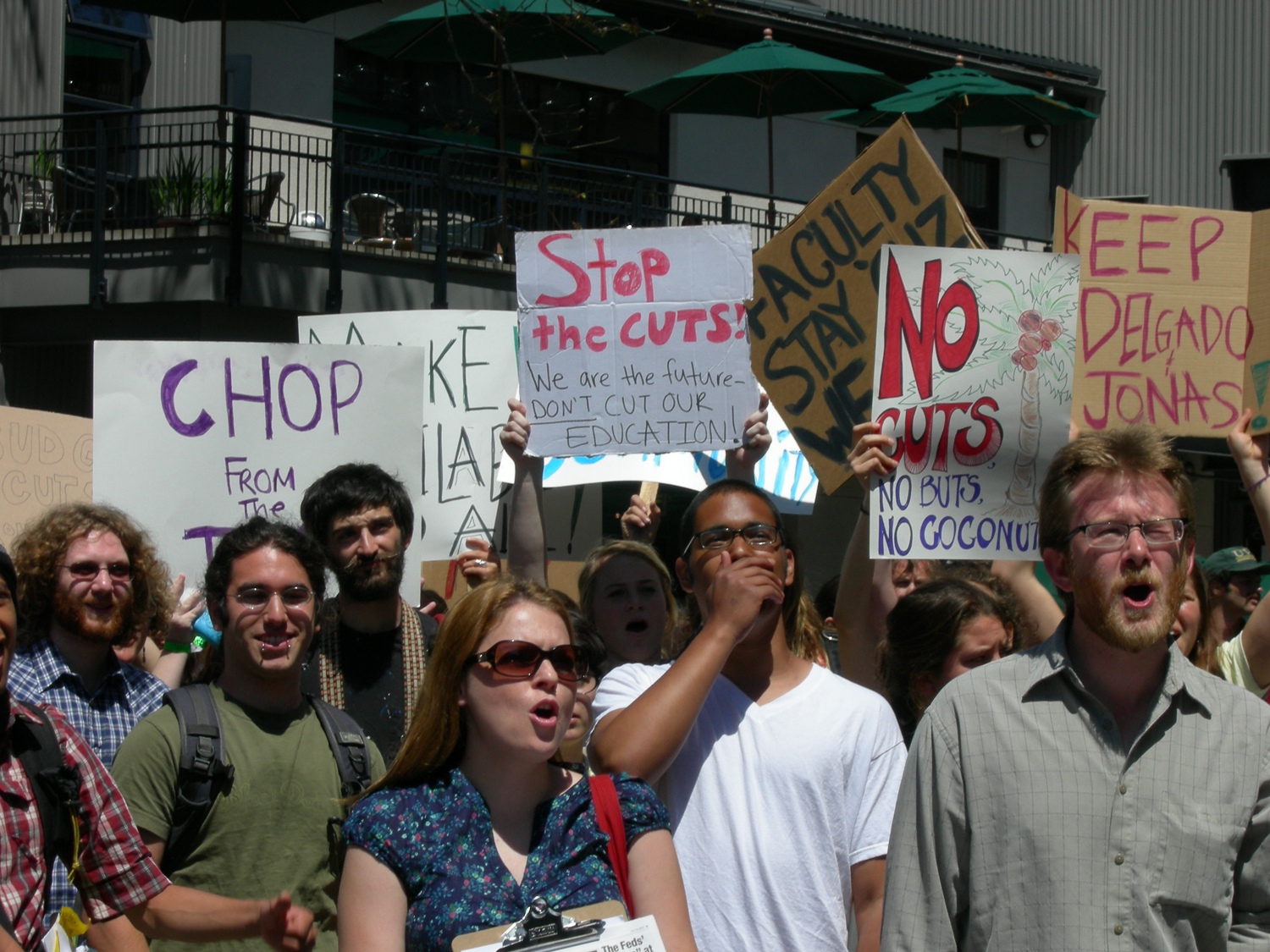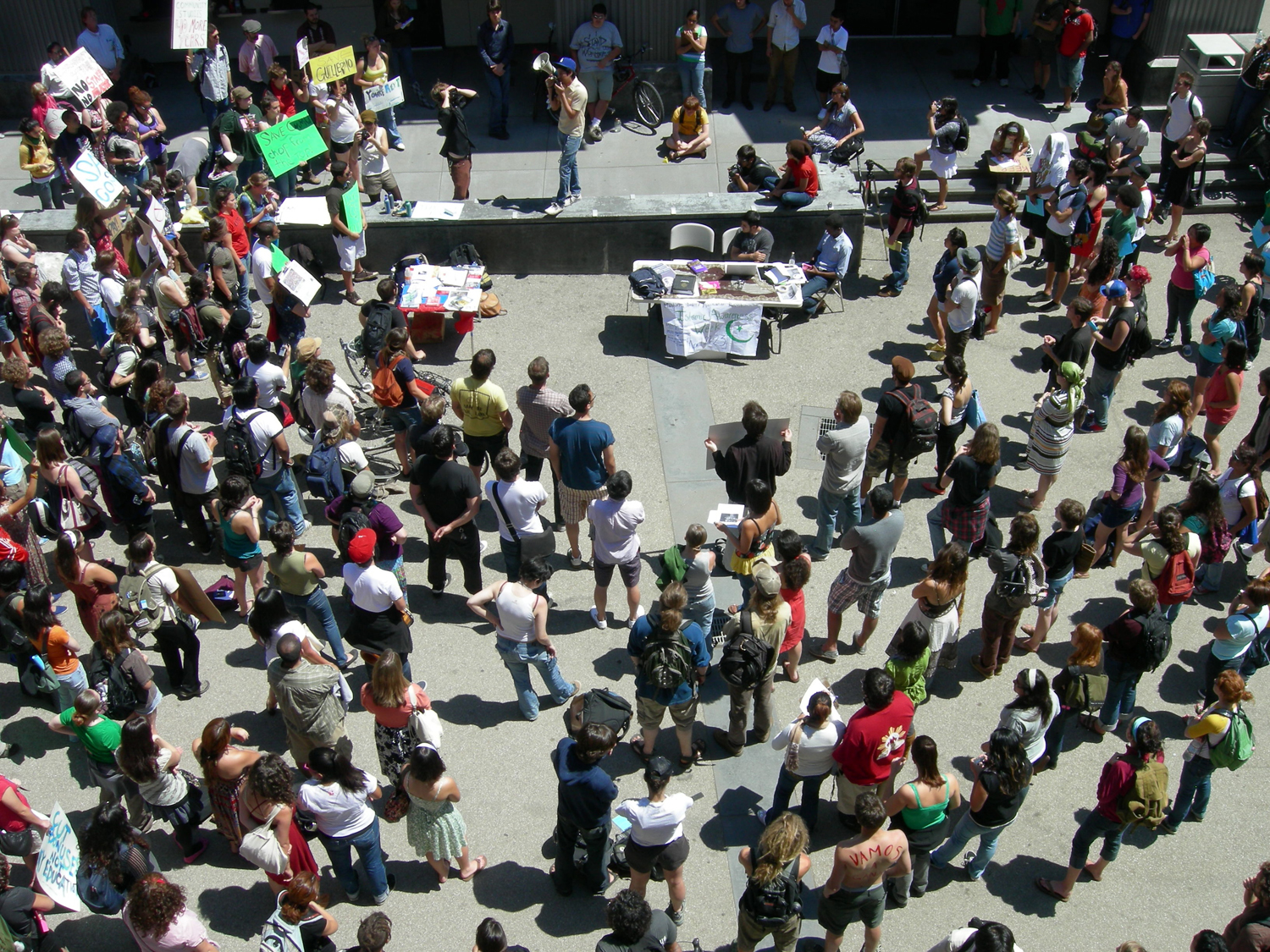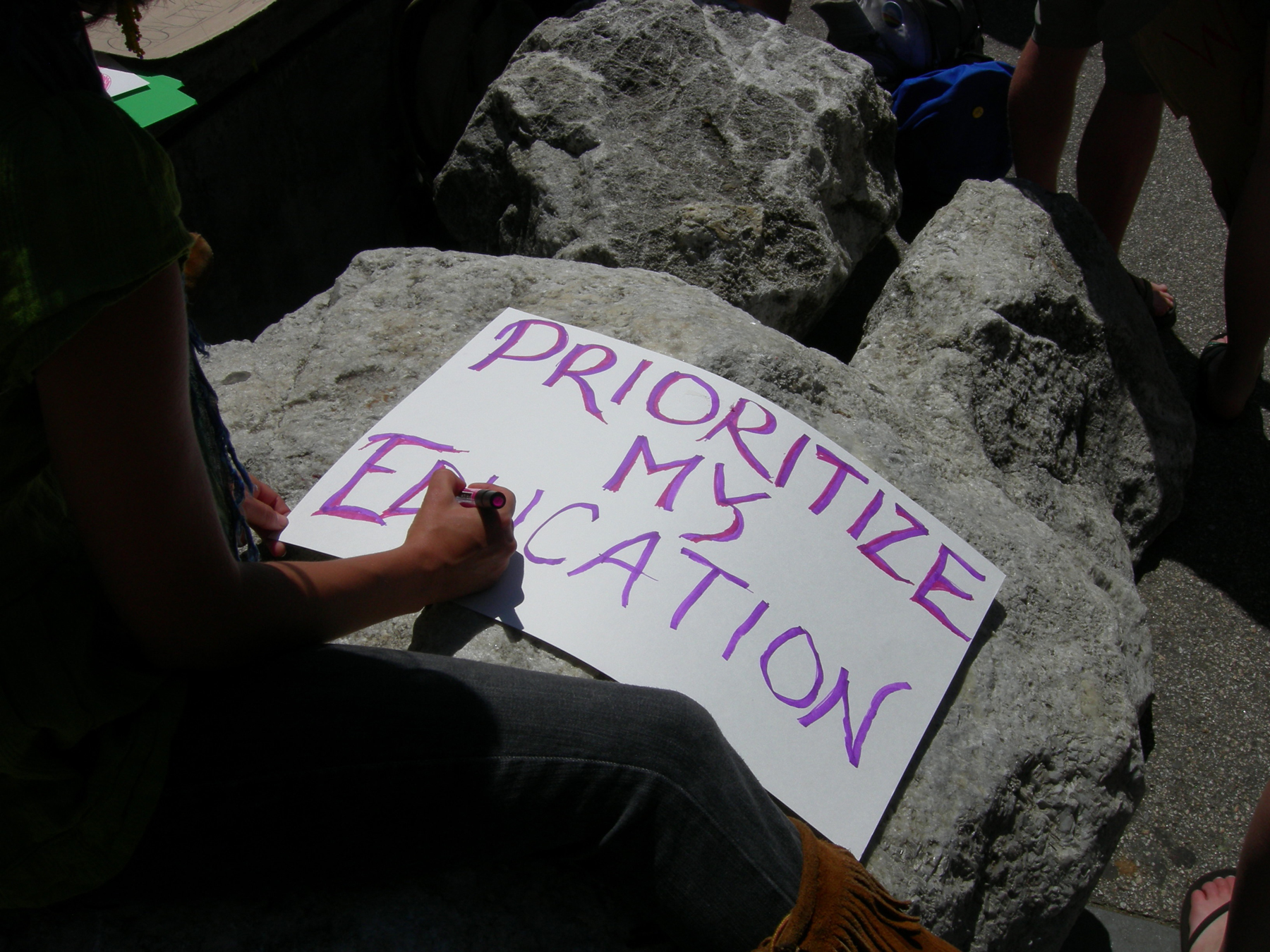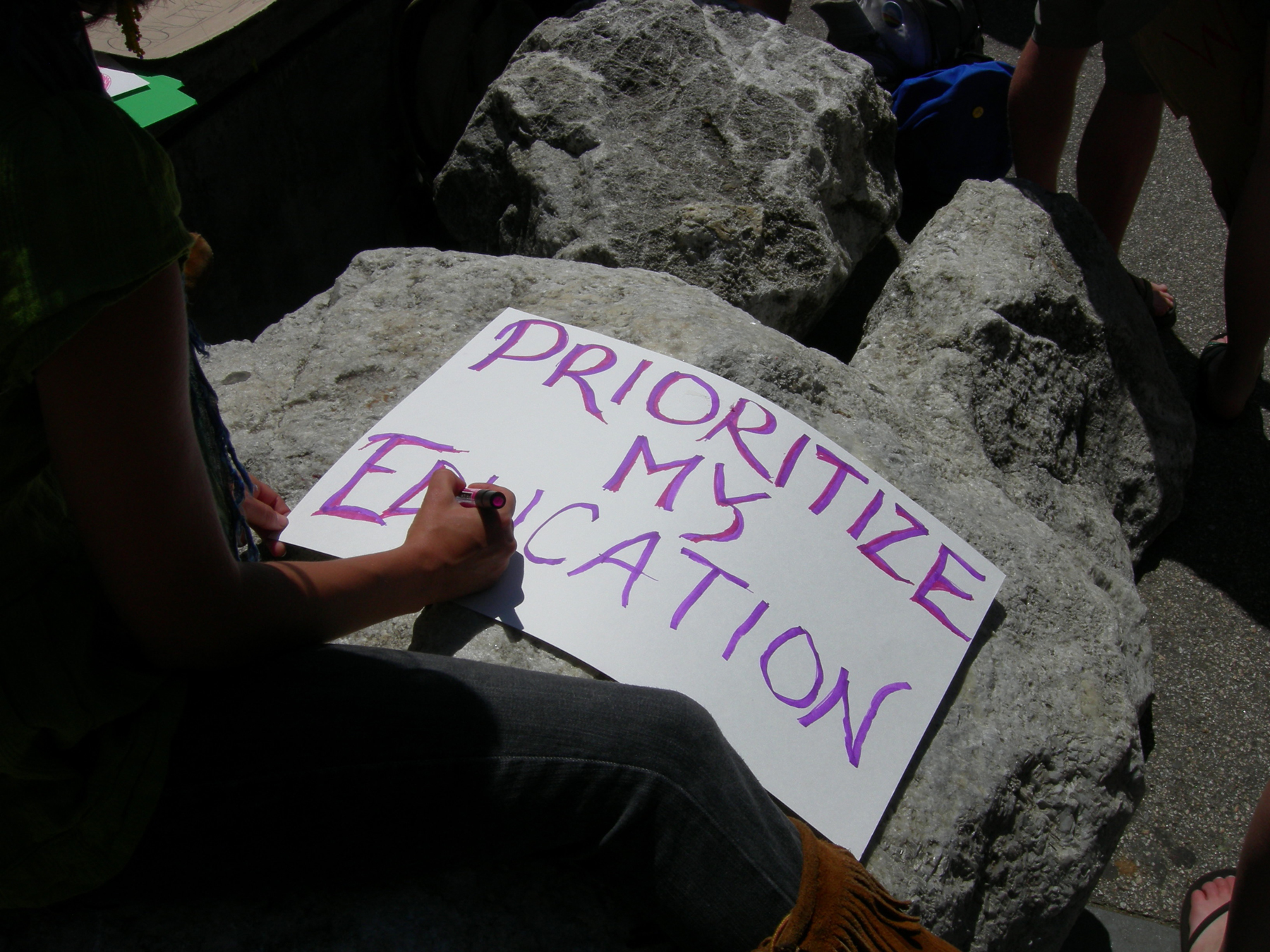 |
| Photo by Victor Morales |
It’s yet another blow to Bay Area public college students who have already felt the negative effects of budget cuts spurred by California’s fiscal crisis – if university administrators have their way, educators say.
University of California and the California State University officials are in the process of raising tuition fees to offset the budget cuts. On Thursday, UC Board of Regents will discuss a $662 undergraduate fee increase during a meeting, while the CSU Board of Trustees will meet to consider raising fees by $306.
“Not only are we shutting people out of the university cause we’re not funding the institution, but now we’re piling barrier upon barrier upon barrier on all those kids whose families are not going to be able to pay the extra fees,” said Lillian Taiz, president of the California Faculty Association.
City College of San Francisco officials also are concerned that university fee increases could put additional pressure on junior colleges.
“If they cannot afford to go to a four-year college, they will explore the California community colleges,” said Martha Lucey, City College’s dean of marketing and public information. “We are funded at a certain level from year to year and if there is a spike in enrollment, the state will not reimburse us sufficiently for the growth.”
The proposed fee hike would bring full-time undergraduate fees to $3,354 per academic year, while graduate student fees would amount to $4,134. CSU officials said the fee hike would generate $127 million in revenues to help offset the loss in state funds, adding that even with a hike, CSU fees are still among the lowest in the nation.
Meanwhile, UC regents are proposing a $662 undergraduate fee increase, which would provide $152 million in revenues.
Federal stimulus funding and increases in the education tax credit will offset the higher fees for many students, according to UC officials.
"The average Pell Grant is going up almost as much as our fee increase," said UC President Mark Yudof in announcing Friday the proposed 9.3 percent increase. "More than 81 percent of the families below $180,000 in household income won’t pay the increase as a result of the federal tax credit and the increased Pell Grants."
UC and CSU officials proposed the fee hikes to maintain the quality of education and cope with budget reductions, which come at a time when the state is grappling with a projected $42 billion deficit.
After Governor Arnold Schwarzenegger released the proposed budget for 2009-10 earlier this year, CSU estimated that it would face a two-year fiscal deficit of $600 million, while UC’s shortfall would amount to $450 million over the same period. Through the American Recovery and Reinvestment Act, UC and CSU will split $537 million in stimulus funds – about $268 million per system. The money backfills cuts already made, bringing the two institutions no closer to filling the multi-million dollar gap each must tackle.
"We still face a major budget shortfall of at least $437 million at the University of California,” said Yudof in a statement about the stimulus funds.
Aside from proposed fee increases, UC and CSU officials have trimmed enrollment, frozen senior management salaries and curbed new hiring among other tactics. UC also instituted a voluntary separation option, which gives staff members the choice of leaving their positions with severance pay. Even with these measures, university officials have no illusions about what could lie ahead.
“We don’t know how deep the cuts will be when everything settles, next summer or fall,” said George Breslauer, UC Berkeley executive vice chancellor and provost, in a discussion about the budget earlier this year.
UC Berkeley’s estimated shortfall could total between $60-70 million, which includes reductions for the coming school year and previous cuts carried over from 2008-09.
At UC Santa Cruz (UCSC) – where a large percentage of students are from the SF Bay Area – spokesman Jim Burns said officials are bracing for deeper cuts beyond its campus’s $13 million budget reduction figure.
“We don’t even have an official number yet,” Burns said. “Since these cuts have to take effect July 1, we’re using $13 million as a planning figure.”
The UC and CSU budget outlook also hinges on the outcome of Proposition 1A, which voters will take up during the state’s Special Election on May 19. Proponents of Prop 1A, including the governor, say this will restrict state spending while protecting education funding. Opponents counter that education will suffer further.
While officials from the UC and CSU systems feel the pressure to slash costs and implement cuts by July, both currently enrolled and aspiring college students are running into serious challenges of their own.
Tighter enrollment, stricter requirements
 |
| Photo by Victor Morales |
In November, CSU officials announced for the first time that the system would have to turn away qualified students because of budget cuts. CSU Chancellor Charles Reed confirmed that the 23-campus system would receive $2.97 billion in state funds for 2008-2009, the same amount as the previous year and $215 million less than what was needed to cover enrollment growth and other costs. UC system funding also stayed flat – at $3.3 billion – with no extra money for enrollment increases.
As a result, the CSU, with an enrollment of almost 450,000, is accepting 10,000 fewer students for the 2009-2010 school year. UC officials followed saying it would reduce its enrollment by 2,300 students. Officials from both camps expressed their reluctance to cap enrollment, but said this was a necessary move to maintain the quality of education.
At San Francisco State University, about 300 fewer students are being accepted for the fall semester, which breaks down to 100 fewer freshmen and 200 fewer returning students or those with a Bachelor’s degree. To accomplish this, the university moved up registration date deadlines, considered students with slightly higher GPAs and test scores and required applicants to be living in one of nine Bay Area counties to get in, said Jo Volkert, SF State associate vice president of enrollment management.
While UC Berkeley’s enrollment is staying steady, UCSC has reduced its freshmen admissions by 335 students, employing tactics similar to CSU in deciding which students get accepted. UCSC had the biggest drop in its admission rate out of all the nine UC schools, accepting 10.6 percent fewer students than the previous year. About 30 percent of previously enrolled freshmen were from the San Francisco Bay Area, according to UCSC’s most recent statistics.
Although fewer freshmen were granted admission, the one bright spot for both university systems is an agreement to increase the number of transfer students. The UC is taking in 500 more transfer students for the 2009-10 school year, while CSU campuses like SFSU are admitting the same number of transfers as last year.
“High school graduates may not be as affected by the enrollment restrictions as transfer students who must move onto a four-year institution,” replied SF State’s Volkert, when asked why transfer rates would remain steady. “High school graduates still have the option of attending a community college.”
But senior Sarah Wong from Dinuba High School in the Central Valley believes many students who didn’t get into universities where they applied may be discouraged from going to college altogether.
“Getting rejected and then having to go to a community college may not be what they want to do,” she said.
Wong and her closest friends are set to go to CSU schools, but she worries about entering SF State at a time when the number of classes are shrinking.
Decline in quality of education
At SF State, Shell Ramos, 21, an international relations major, was supposed to graduate next May. But because of course reductions, she can’t get enough classes.
“It was kind of like a nightmare,” she said. “It’s really difficult not being able to get classes and then having to get on all these wait lists.”
Now, it could take up to two years more for her to graduate. By then she’ll have been in college for five to six years, which was not part of her plan.
SF State Assistant Professor Ramon Castellblanch, also president of the campus’s chapter of the California Faculty Association union, said the university cut 150 course sections this spring semester and about 141 last fall.
“There’s fewer classes,” he said. “It’s basically denying access to students, which affects their entire careers and lives.”
Because of course reductions, class sizes are ballooning, bringing down the quality of education at the university, said Castellblanch, who has taught upper-division courses in health education for seven years. At this level, he said, students should be able to work more closely with the professor to maximize their learning experience and receive mentoring. But since he has 60 students in each of his two classes instead of the ideal 30, he said it’s impossible to get to know all of them.
When asked for a response from SF State officials about Castellblanch’s concerns, spokeswoman Ellen Griffin said comment should be reserved for Dean Don Taylor of the College of Health and Human Services to which Castellblanch’s program belongs. Taylor did not return phone calls or answer emails from The Public Press.
While CFA’s Taiz said it’s difficult to quantify how class size and course reductions impact the quality of education, she did say “with so many students and less classes, it makes it almost impossible to do the kind of job you want to do to help your students. It can’t help but hurt the education the kids are getting.”
“Those are very realistic concerns,” said Debbie Cochrane of the Institute for College Access & Success in Berkeley, a non-profit organization that conducts non-partisan research around higher education issues. “You can’t continue to decrease the amount of funding that a system has or that any program has and continue to maintain the level or amount of service that it’s currently providing.”
At Santa Cruz, the potential for growth in class sizes is a real possibility, according to university spokesman Jim Burns.
“Will there perhaps be larger classes? Possibly. Will there be reduced services if departments are consolidated or staff are let go? There’s no doubt about that,” said Burns. With the scale of cuts, he added, there will be pain and impact – something even UC Berkeley officials have acknowledged.
Lecturers and support staff jobs on the line
Late last month, more than 200 UCSC students staged a walkout and rally to protest budget cut proposals. Many of the students and supporters voiced their concerns that the budget axe would fall heavily on the Community Studies and the Latin American and Latino Studies departments. Earlier this month rumors surfaced that UCSC officials planned to eliminate the community studies program, a major focused on social activism and that two prominent LALS lecturers would be let go.
 |
| Photo by Victor Morales |
“If they let go of the two lecturers, we’re losing 12 classes,” said student Robert Gutierrez, an LALS minor. “That’s 20 percent of the LALS department, so in a way they’re cutting classes because they’re not going to be able to find anyone else to teach those classes.”
Burns said students and supporters are assuming incorrectly that decisions have been made. School officials have until May 15 to decide how cuts will actually be implemented. Even before the student rally, Sheldon Kamieniecki, dean of the Social Sciences division that oversees community studies, attempted to allay students’ fears that the program would be eliminated.
“Contrary to rumors, there has been no decision, or even a formal proposal, to discontinue the community studies major," Kamieniecki said in a campus-wide memo. "We are considering eliminating administrative-support positions in community studies. Administrative support for this academic program will continue and will be provided by one or more of our social science departments.”
But community studies lecturer Sean Burns – who is not related to UCSC spokesman Jim Burns – said even if the major itself isn’t in danger of going away, the proposal to eliminate staff members could eventually lead to the program’s demise.
“The notion that, no, the administration is continuing the department, is disingenuous in the sense that, de facto, if you cut out the number of staff positions, the lecturers who have been teaching critical studies in the department and try to disperse the faculty in other places around campus, the 40-year-old program of community studies will end,” he said.
Both Sean Burns, a longtime UCSC lecturer, and Castellblanch of SF State agree that California’s public higher education is in crisis and that state and federal officials need to do more before it gets worse.
“Community college and the public university system is the gateway into being a worker in the 21st century,” said Burns. “For us to be undermining fiscally these programs from K through university is just so short-sighted.”










